The best vintage sewing machines last forever and can sew through almost anything! For example, vintage Viking machines made in Sweden often still run like a dream today. To find out if a Viking model is right for you, you probably want to learn all about vintage Viking sewing machine models, history, and value.
Husqvarna began as an arms manufacturer in 1689 and soon moved into the sewing machine business. The company made a name by designing innovations like using self-oiling sintered steel and an easy-hold bobbin case. Today, Husqvarna continues to sell high-caliber sewing machines designed in Sweden.
In this article, you’ll find out where Viking sewing machines came from. You’ll also learn all about Viking’s most popular models over the years. Finally, you’ll get information on how to buy or sell a vintage Viking machine!
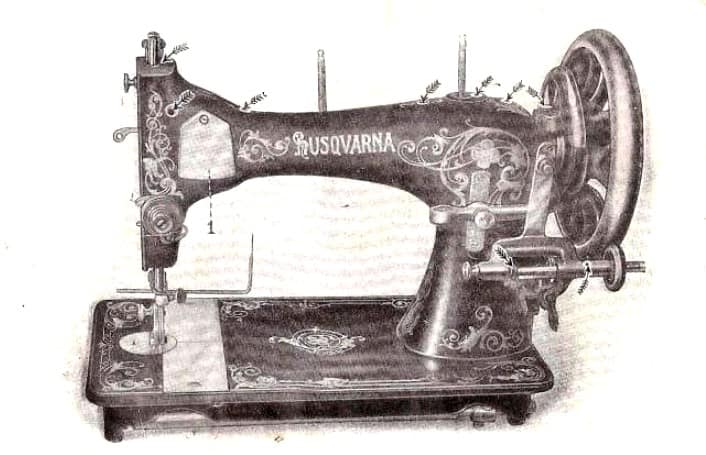
History of Viking Sewing Machines
Husqvarna Viking has a long history as a manufacturing company stretching back to the Middle Ages. The company made its name in domestic appliances starting in the late 1800s. They continue to deliver stellar sewing machine models today.
As early as the 1300s the small Swedish town of Husqvarna (spelled Huskvarana today) made a name for itself as a place where things got made and built. Specifically, the town supplied weapons to the Swedish royal family, a practice that continued for centuries.
As times changed, much of the manufacturing transitioned over to making firearms in the 1600s. Making muskets required pretty complex mechanisms.
Husqvarna opened its first official manufacturing factory in 1689. The launch of the factory in 1689 is listed as the official founding date of the manufacturing company.
At this time, Husqvarna primarily produced muskets in a factory powered by the impressive nearby waterfalls.
The next big change for the company didn’t occur until a century later, when the royal family of Sweden sold the factory into private ownership in 1757. This is the point at which the company began to call itself “Husqvarna” as well.
The change in ownership and name didn’t make a difference to the factory, though. It continued to produce firearms until the middle of the 1800s. At this point, the impact of the Industrial Revolution on global economies convinced Husqvarna to make a sharp about-face. The company continued to sell firearms but added a line of domestic items such as bicycles and sewing machines.
Even in its early years, Husqvarna made several very successful sewing machine models. For example, the “Freya,” continued to sell until the 1940s because of its popularity!
The company also made a name for itself by manufacturing incredibly sturdy and easy-to-use sewing machine models. These worked super well in classrooms across Europe!
You probably recognize the Husqvarna Viking brand name today as an indication of high-end, quality sewing machines. While the brand does continue to design and sell new models today, the company is now owned by SVP Worldwide, which also owns Singer.
Viking Sewing Machine Models
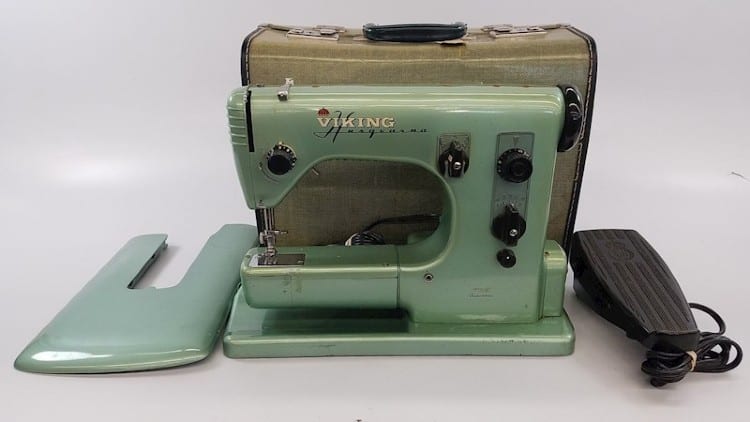
If you’re trying to classify a vintage Viking sewing machine, you probably want to learn about popular models from the past.
But first, what’s in a name? The official brand name for these machines is “Husqvarna Viking.” But you will often see the models referred to as either just Husqvarna machines or just Viking machines. The names often get used interchangeably.
Some of the earliest models sold in America used the brand name “Viking.” Perhaps the company made this choice because this name would seem more familiar to English speakers than “Husqvarna.”
Fans also sometimes simply call them “Huskies,” as a term of endearment!
Another key thing you ought to know is that not every vintage Viking has a brand name or clear marking on it. This means you often have to try to identify your machine based on style and characteristics alone.
Antique Husqvarna Models
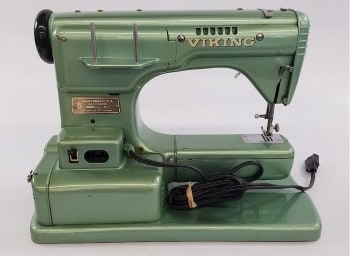 Husqvarna Viking’s best-known antique models include the North Star, the “Weed” model, and the Freya.
Husqvarna Viking’s best-known antique models include the North Star, the “Weed” model, and the Freya.
Sewing machines made before the 20th century usually fall into the “antique” category. The company began manufacturing domestic sewing machines around 1870. This means that several of their early models count as antiques rather than vintage models today.
In 1874, Husqvarna sold a sewing machine called the North Star. This model had a lovely arched arm and a delicate cast-iron frame.
The company only made about five hundred North Stars due to some unfortunate functionality issues. Today, this machine is considered an extremely rare collector’s item because so few still exist and because of its pretty design.
Presumably wary of testing out an original design again, the company next procured the rights to produce the “American Weed” model. This second model worked reliably and quickly became popular!
Operated by a hand crank, this machine still has a delicate-looking arm and cute cast-iron paw feet on its stand!
This new Husqvarna sewing machine sold super well up until 1895. This leads to Viking’s most popular antique/vintage model, the Freya!
The Freya (or Freja) model was manufactured from 1883-1925 and continued to sell well into the mid 20th century because of its high popularity.
This model features similar characteristics to Singer’s transverse shuttle model. In fact, so did many other European sewing machines at the time! However, many Freya models have a more square, Nordic shape to the arm than the Singer model.
This model also used sintered, self-oiling steel in an innovative way. It ran super smoothly and served as a popular choice for many Swedish and Finnish households. The Freya also did quite well in overseas sales in America and Britain!
Most Freya models have lovely golden decals painted onto the body of the machine. The name usually appears in curling golden letters on the front of the arm. Sometimes “Made in Sweden” appears on top of the arm as well.
Viking Sewing Machines Pre 1980
Viking made many popular models during the first half of the 20th century. Sewing machines made between 1900 and 1960 usually get termed “vintage” instead of antique.
Besides the Freya, which technically transitioned from an antique to a vintage model, you can find the Triumf, the 19e, and the Nordic, among others.
This is by no means a comprehensive list of every vintage Viking model ever made. But it will give you a good idea of the general characteristics that developed during this era!
Triumf
Sold until 1931, the Triumf used a unique tension calibration. This machine still looks pretty antique with its black sintered steel body and artful golden deals. It operated as a vibrating shuttle machine.
Some models may have the name “Triumf” painted onto the front of the arm. While you may encounter this vintage model at estate sales or antique stores, you won’t see a lot on eBay or Etsy because they are pretty rare today.
CB Class 15
Husqvarna produced the CB class 15 from 1910-1930. This model implemented many features you can see in the Singer model 15, such as reverse capability. (Many early sewing machine companies copied Singer, which led to quite many legal skirmishing over the years!)
This machine got a lot of publicity as a modern marvel in the 1920s and had good sales in Europe. Some of these models will feature the brand name “Husqvarna” across the arm, and most will have “Made in Sweden” painted on the base.
33-10 Zig-Zag
The 33-10 introduced the zig-zag stitch as well as a rotary hook. First sold in the 1930s, this cute little guy has a greyish-blue paint coat. If you’re lucky, it will come with small plates nailed to its body to indicate its model name.
Though this is an electric machine, you might find it a bit challenging unless you’re accustomed to working with external drive belts. Despite that, this machine is considered a heavy-duty model that can still run well with careful maintenance!
Model 19e
The 19e model hit the shelves in 1938 as one of Viking’s earliest electric machines. It features a rotary hook and is considered the best vintage Viking by some sewers today. It has a shimmery, pale metallic green color that makes it especially attractive.
Though it only offers a straight stitch and reverse, the 19e has a powerful and smooth motor. It can also use a twin needle, making it super useful for quilters!
Nordic
The Nordic was launched in the decade between 1950 and 1960 and was the last model to use all-metal components. With its bright green color and bold model name printed right on the front of its arm, this model at least offers easy identification!
Though it marks the end of the vintage Viking era, the Nordic remains an outstanding model in its own right. It can sew through just about anything and provides regular, consistent stitching and a smooth, electric motor.
Modern Viking Models
Modern Viking models include popular designs such as the Sapphire 930 and the Designer Diamond.
Brand-new models cost anywhere from about $600 for a basic starter model to $5000 for a high-end model.
The company still has its base in Sweden and performs the design process at that location. That said, most manufacturing happens overseas in China.
Also, models made anywhere from 1960 on may include plastic gears and parts inside. Modern sewing machines have incredible functionality.
That said, they lack the solid metal parts that keep vintage models running for decades. You can’t expect a modern machine to last nearly as long.
The Sewing Advisor, a computerized process that allows the machine to self-select settings like tension and stitch length, makes Viking machines special today. This innovative design gives high-end Viking machines a leg up above much of the sewing machine market.
Viking Sewing Machine Serial Number Lookup
You may have a difficult time looking up Viking sewing machine serial numbers. The Husqvarna company did not always include serial numbers or even model names on the machines they made in the early years.
Even if you find a serial number on your vintage model, it might not help! To date, no one has compiled a list of models and their relevant serial numbers that would allow you to match your number to the name of the model.
Husqvarna Viking has a great reputation for providing support on its current models. But the company does not provide a wealth of information on recent older models, let alone their vintage and antique models!
If your vintage Viking has a serial number, you can usually find it on a metal plate bolted to the machine. Check either the underside of the base or one of the sides of the base.
You can try Googling this number to see if anyone on a sewing forum has posted information about that model.
The best way to identify your model, though, will be to compare the features of your machine with online descriptions. For example, you can note the machine’s color, the kinds of stitches it can make, and the type of bobbin casing.
Then compare your notes with online descriptions to find out what model you have!
Viking Sewing Machine Prices
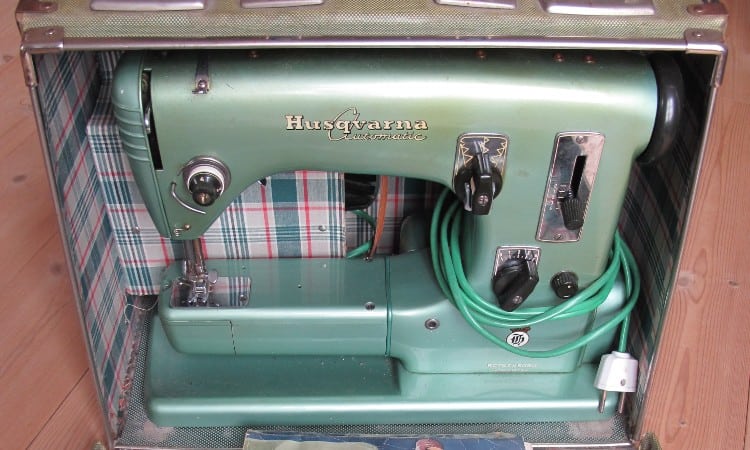
Source: Lisa Risager
On average, most vintage Viking models sell for around $200 today. This price can vary depending on the condition and collectibility of an individual model, as with most vintage items.
Why can you buy a vintage model for so little when modern Viking models cost so much? Well, most vintage Viking models were produced in the thousands. This means that you can still find them pretty easily today and they don’t have high collectibility.
Also, you may value a vintage machine for its solid craftsmanship and durability. But modern Husqvarna machines are all about computerization and highly advanced sewing technology. Their complex capabilities make them expensive to produce and pretty pricey to buy.
You can almost always find vintage Viking models for sale on eBay, Amazon, or Etsy. You can also search reputable dealers, antique stores, or even thrift stores. You may have a better chance of tracking down one of these vintage beauties at a yard sale or thrift store if you live in an area populated with people of Swedish descent!
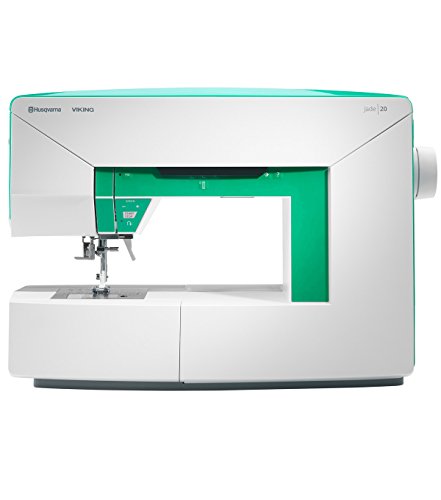 As one final complication, you should also know that a Canadian company also briefly sold sewing machines under a Viking brand name. These machines were not made by Husqvarna! They seem to primarily have been made by White, an American company that sold a lot of “badged” sewing machines under the brand name of other companies.
As one final complication, you should also know that a Canadian company also briefly sold sewing machines under a Viking brand name. These machines were not made by Husqvarna! They seem to primarily have been made by White, an American company that sold a lot of “badged” sewing machines under the brand name of other companies.
You will need to do some detective work and make sure the machine you want to buy or sell has the features associated with Husqvarna models.
Finally, keep in mind that a lot of the value in a vintage sewing machine comes from its functionality, not its price tag. You can use a well-maintained vintage machine for basic sewing tasks for many decades. Its durable solid metal interior will keep on running!
Vintage Viking Sewing Machine Parts
It’s a good idea to know where you can find vintage Viking sewing machine parts should the need arise. Even the sturdiest old appliances need maintenance and repairs on occasion!
Fortunately, you can usually find a good supply of vintage Viking parts on Amazon, Etsy, and eBay.
Here’s the bad news, though: finding a technician trained to repair old Viking machines can prove extremely challenging. Plus, you may have trouble locating the original manual that will tell you how to clean and repair your machine.
For a fee, you can purchase many vintage manuals from this website or check eBay. Otherwise, you can join a sewing forum online and ask if anyone can share a digital copy of the manual with you.
What is the Best High-End Sewing Machine?
Generally, Bernina, Juki, Janome, and Viking machines rank as the best high-end sewing machine models today.
You may wonder how Viking machines rank in comparison to other top brands today. Especially now that you know more about Husqvarna Viking’s long and illustrious history! Is Viking the best?
This depends on your sewing preferences. Modern Viking models certainly deliver advanced features and incredible functionality. The brand has a sterling reputation, and many long-time sewers love their “Huskies!”
That said, if you go by price, some Bernina machines sell for upwards of $20,000. This indicates that these Swiss machines rank even higher than Vikings in terms of quality and brand respect.
Despite that, you really can’t go wrong with either a vintage or modern Husqvarna Viking machine! Every model comes with its unique features, but nearly all of them consistently deliver. You can count on the vintage models to keep running for many years to come!
Conclusion
Viking sewing machines come with a rich history and an excellent reputation for long-lasting usability. Vintage models like the Freya, the 19e, and the Nordic kept in peak condition still run smoothly today, after decades of use!
Typically, vintage models cost as little as $200, but identifying the models can prove challenging! While vintage Viking machines remain popular among sewers today, dating and identifying the models can prove tricky because the machines cannot match any current list of serial numbers.
Do you own a vintage Viking sewing machine? What do you like best about it? Leave a comment below to let us know!
Sherrie
Monday 8th of November 2021
About 1957 a salesman came to our farm, selling one of those green machines. My sister and I were in high school and dad had given us two runt pigs which we raised. They were about ready for market when he came. So my dad listened and examined it (he was a repairman for a shirt factory earlier in his life)and told us if we wanted to use the money for the sale of the pigs, he would pay the rest. Mom used that machine until her death in 2016 and my niece now has it. I also have a Viking, maybe 40 years old now. Still great.
Jeri Marlia
Saturday 23rd of October 2021
I have a vintage Viking Husquarna CL8 110-120V AC DC 1.5 amps sewing machine that I’m wanting to sell. Still runs great!
Helen Smith
Wednesday 1st of September 2021
Hi, I have two of the Husqvarna Vintage green coloured machines. One is the Husqvarna Automatic and the other the 19E. I just love these machines, so reliable, will stitch through virtually anything and are a joy to use. They are not freely available in Australia and have become quite collectible.